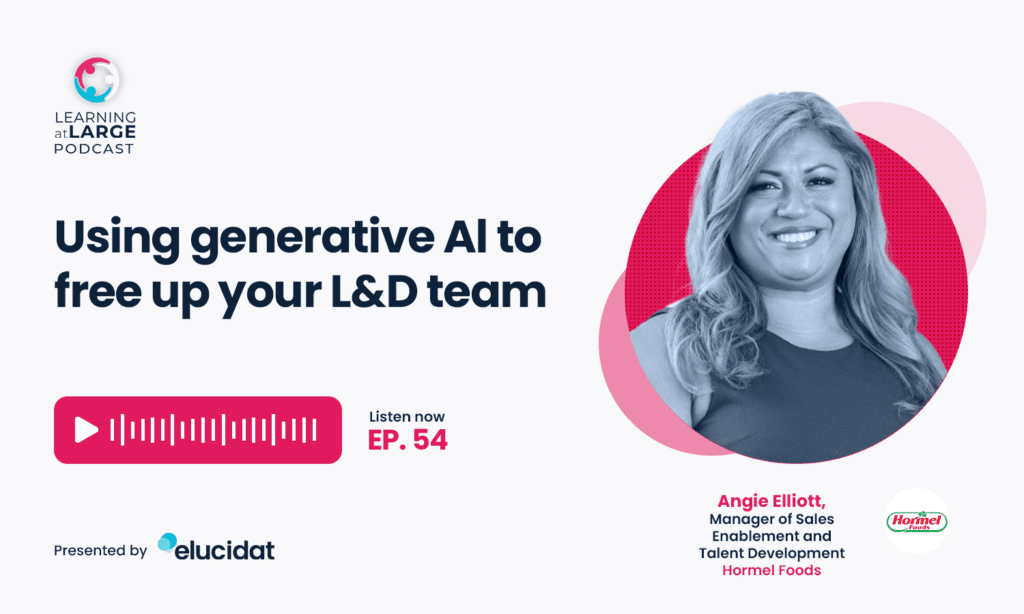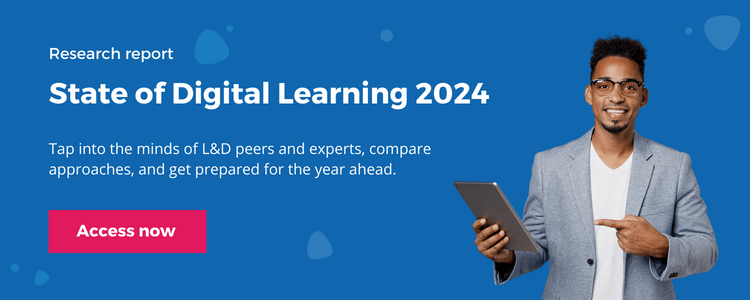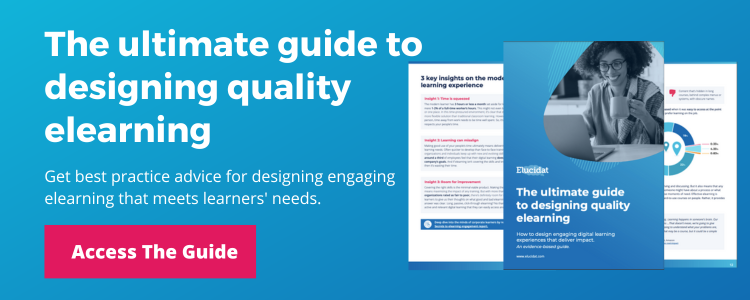Using Generative AI In L&D: Angie Elliott
We’ve all heard about the game changing powers of generative Artificial Intelligence (AI). But what does it look like in practice? Angie Elliott, Manager of Sales Enablement and Talent Development at Hormel Foods, shares how she’s using generative AI models to bring back something that we all want and miss: time. Discover how AI is freeing up L&D to focus on what’s important. Dive into her practical time saving tips that are anything but lazy content hacks.

Top tips for using generative AI to free up your team
Don’t have time to listen now? Here are some top tips from Angie:
- Start by experimenting: Whether it’s text generation or fully developed storyboards, try things out. Find out how the tech can move your projects forward.
- Don’t see tech as your competition: Think of generative AI as your research assistant. It can help you get a head start, but it doesn’t replace design thinking.
- Get structured: ChatGPT uses freeform text entry. But if you want quality output, you need quality input. Hit the sweet spot with structure prompts.
- Refocus on strategic activity: Use the time that generative AI recaptures to focus on strategic tasks, like analysis, consulting, and future skills development.
1. Start by experimenting
As a lifelong learner, Angie is always paying attention to what’s happening in the learning technology space. So, when ChatGPT started popping up in every LinkedIn post late last year, she couldn’t wait to find out more.
Angie immediately started exploring what role generative AI could play in her work. She was keen to see how it could help her recapture one of the resources that we all have the least amount of: time. Before long, she was using it multiple times a day – from writing the biography of an important presenter (check out the end of the podcast!) to developing authoring tool specific storyboards.
“In about 15 to 30 minutes, I can get from a simple content outline all the way to a storyboard or even a script…I’m giving the leader or the project champion something to review, edit, react to and provide feedback. And then suddenly, everyone’s looking at the L&D department and saying, ‘Wow, you really sped up this process for me’.”
2. Don’t see tech as your competition
Of course, not everyone is embracing this technology like Angie. While some people, are diving right in with generative AI, others aren’t so sure. They’re nervous about what the future might look like for human intelligence. After all, if generative AI can do all these things, what’s left for the L&D team?
Angie is clear that AI systems are not removing the need for any L&D roles. Instead of seeing technology as a replacement, she likes to think of it as a research assistant. It can help you get a head start and move the project forward, but can’t do everything.
“AI is not replacing any of the roles that I’ve ever been in in L&D. I still have those technical knowledge requirements. I still need to review all of my content for accuracy. Instead of thinking about it as in competition for your job, we just need to see it as an enhancement or an accelerator.”
3. Get structured
Angie’s early experiments with generative AI provided some valuable learnings. She initially started by asking a question. Often, she would use the same chat again to ask another question. The results were all over the place.
Angie quickly fine-tuned her approach. Although ChatGPT uses freeform questions, it works much better with structure. So now she uses an (appropriately food related) acronym to structure her prompts: TACO. She makes sure her prompts include who the AI should Act as (e.g. an instructional designer), the Task (e.g. create a learning opportunity on ecosystems using Gagne’s nine events of learning instruction), Context (e.g. the audience is content developers) and Output (e.g. a storyboard for Elucidat).
“ChatGPT really will react much better if you use structured prompts – a series of structured prompts plus freeform prompt or just multiple structured prompts. That’s really where the sweet spot is for those generative AI tools. So, when I approach ChatGPT to start gathering information and creating materials and content, I put it into an acronym: TACO.”
4. Refocus on strategic activity
Supporting more than 20,000 people worldwide, generative AI has been a game changer for Angie’s small team. Their new research assistant has transformed the way they work.
Using AI has not only sped up the content development process and decreased the amount of time it takes to bring a product to life. It’s freed the team up. Now they’re no longer stuck in the detail of content creation, research and aggregation. They’re free to focus on what’s really important: analysis, consulting, strategy, and future skills development.
“Our experience is best utilized, as learning professionals, in understanding how to use the prompts, how to get the most content out of the generative AI tool, and then speed up that process so we can get more content out more quickly. That frees us up to do more of the work that I love. The analysis part of the ADDIE model. Skills inventories. Evaluation of behavior change, and if we’re getting any return on our investment.”
A quick recap
Beyond all the hype, there are plenty of practical benefits of generative AI. Angie has four strategies for busy L&D teams to make the most of this new technology:
- Experiment to find out how this tech can move your projects forward at an accelerated pace.
- Think of generative AI as your research assistant, rather than as competition for your job.
- Structure your prompts to get the best quality output from generative AI tools.
- Take the time that you recapture using generative AI and focus on strategic activity.
Want to find out more? Check out the full podcast.
About Angie
With over 20 years’ experience in HR, Angie has held a wide range of roles – from facilitator to learning leader. As Manager of Sales Enablement and Talent Development at Hormel Foods, she is responsible for the entire employee experience in the learning ecosystem space.
You can find out more and get connected with Angie on LinkedIn.
On Angie’s reading list
Find out what books are in Angie’s professional development library.
This book guides you through the knowledge and skills you need to produce engaging learning experiences in a virtual space.
Mismatch: How Inclusion Shapes Design, Kat Holmes
It’s critical you think about inclusion and accessibility in learning experiences from the very beginning. Angie says this book helps you see the world in a completely different way.
Looking for more reading tips? Check out our book blog.
Learn more from like-minded learning experts
Interested to hear more from Angie as well as other learning experts and your L&D peers? The State of Digital Learning Report is the place where you can tap into the minds of your L&D peers and learning experts, compare approaches, and get prepared for the year ahead.

